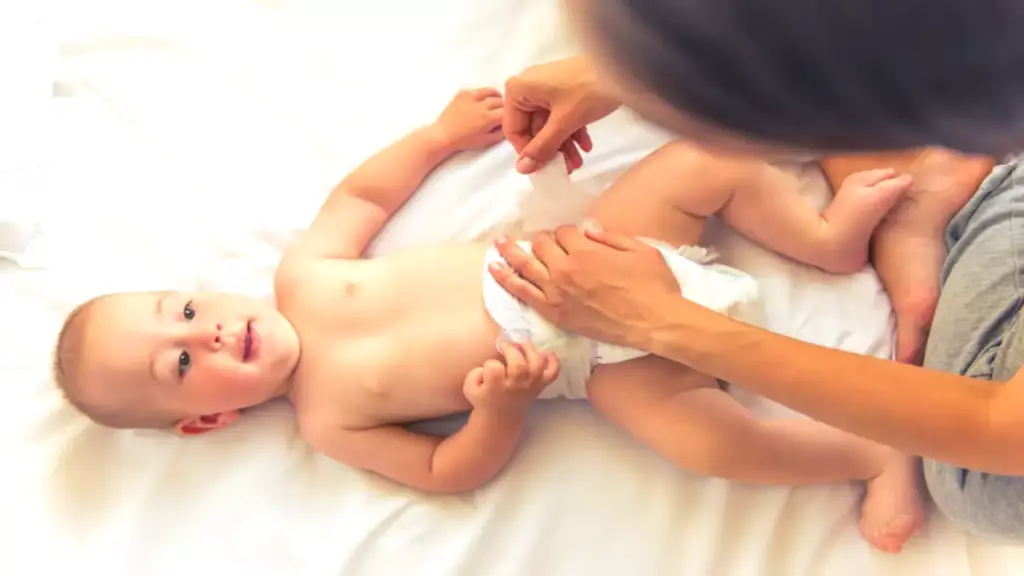Introduction to Diapering for Newborns
Diapering is a fundamental aspect of newborn care that can significantly impact both the baby’s comfort and health. Proper diapering practices help prevent rashes, infections, and discomfort, ensuring a happier and healthier baby. This comprehensive guide aims to cover all aspects of diapering, providing new parents with the knowledge and confidence needed to manage this essential task efficiently. From selecting the right diaper to dealing with common challenges, this article offers detailed insights into the best diapering practices for newborns.
Choosing the Right Diapers
Types of Diapers: Cloth vs. Disposable
When it comes to diapering, parents are often faced with the choice between cloth and disposable diapers. Each type has its own set of advantages and drawbacks:
- Cloth Diapers: These are reusable and often made from natural fibers. They are eco-friendly and can be cost-effective in the long run. However, they require regular washing and may not be as convenient as disposables.
- Disposable Diapers: These are designed for one-time use and are highly convenient. They are absorbent, easy to use, and widely available. The downside is that they can be expensive over time and are not environmentally friendly.
Key Features to Look For
When selecting a diaper, consider the following features:
- Absorbency: High absorbency is crucial to keep your baby dry and comfortable.
- Fit: A good fit prevents leaks and blowouts. Look for diapers with elastic leg cuffs and adjustable tabs.
- Breathability: Diapers that allow air circulation help prevent diaper rash.
- Materials: Choose diapers made from hypoallergenic and soft materials to avoid skin irritation.
Popular Brands and Their Offerings
Several brands are renowned for their high-quality diapers:
- Pampers: Known for their excellent absorbency and softness.
- Huggies: Offers a variety of diapers, including options for sensitive skin.
- Honest Company: Focuses on eco-friendly and hypoallergenic products.
- Luvs: Provides affordable diapers without compromising on quality.
Preparing for Diapering
Essential Diapering Supplies
To ensure a smooth diapering process, have the following supplies on hand:
- Diapers (cloth or disposable)
- Baby wipes or a damp cloth
- Diaper rash cream
- Changing pad
- Diaper pail or disposal system
Setting Up the Diapering Station
A well-organized diapering station makes the process more efficient:
- Location: Choose a safe, comfortable area, ideally at waist height to prevent back strain.
- Organization: Keep all supplies within easy reach. Use baskets or bins for organization.
- Hygiene: Maintain cleanliness by regularly disinfecting the changing area.
Hygiene Practices Before Diapering
Before changing your baby’s diaper:
- Wash your hands thoroughly.
- Prepare all necessary supplies to minimize the time your baby spends on the changing table.
- Use a clean changing pad cover for each diaper change.
How to Diaper a Newborn
Step-by-Step Guide to Changing Diapers
Follow these steps for an effective diaper change:
- Prepare the Area: Lay out a clean diaper and wipes.
- Remove the Soiled Diaper: Gently lift your baby’s legs and remove the soiled diaper. Dispose of it properly if it’s disposable, or place it in a diaper pail if it’s cloth.
- Clean Your Baby: Use wipes or a damp cloth to clean the diaper area thoroughly, wiping front to back.
- Apply Diaper Rash Cream: If needed, apply a thin layer of diaper rash cream.
- Put on a Clean Diaper: Slide the clean diaper under your baby, fasten the tabs securely but not too tightly, and ensure there are no gaps.
Tips for Handling a Wiggly Newborn
- Distract with Toys: Keep a small toy or rattle nearby to distract your baby during diaper changes.
- Sing or Talk: Engage your baby with soothing words or songs.
- Use a Mobile: Hang a mobile above the changing area to capture your baby’s attention.

Ensuring a Snug Fit
A proper fit is crucial to prevent leaks:
- Ensure the diaper is snug around the waist and legs.
- Check the fit frequently as your baby grows and adjust the size as needed.
Dealing with Diaper Rash
Causes of Diaper Rash
Diaper rash can be caused by:
- Prolonged Wetness: Leaving a wet or soiled diaper on for too long.
- Friction: Rubbing of the diaper against sensitive skin.
- Sensitivity: Reaction to certain diaper materials or wipes.
- Infections: Bacterial or yeast infections can also cause rashes.
Preventative Measures
To prevent diaper rash:
- Frequent Changes: Change diapers promptly to keep the area dry.
- Use Barrier Creams: Apply a barrier cream to protect the skin.
- Ensure Proper Fit: Avoid diapers that are too tight and cause chafing.
- Air Time: Allow your baby some diaper-free time each day.
Effective Treatments
If diaper rash occurs:
- Clean Gently: Use mild, fragrance-free wipes.
- Apply Creams: Use a diaper rash cream containing zinc oxide or petroleum jelly.
- Change Frequently: Keep the area as dry as possible.
- Consult a Doctor: If the rash persists, consult a pediatrician for further treatment.
Choosing Diapering Accessories
Diaper Pails and Disposal Systems
A good diaper pail can help manage odors:
- Sealable Lid: Prevents smells from escaping.
- Easy to Use: One-handed operation is ideal.
- Liner Availability: Ensure liners are readily available.
Wipes: Types and Uses
Choose wipes based on:
- Material: Soft and gentle materials to avoid irritation.
- Ingredients: Fragrance-free and hypoallergenic options are best for sensitive skin.
- Packaging: Convenient packaging for home and travel use.
Diaper Creams and Powders
- Diaper Creams: Look for creams with zinc oxide for effective rash prevention and treatment.
- Powders: Talc-free powders can help keep the diaper area dry.
Sustainable Diapering Practices
Benefits of Cloth Diapering
Cloth diapering offers several advantages:
- Eco-Friendly: Reduces landfill waste.
- Cost-Effective: Cheaper in the long run despite higher upfront costs.
- Gentle on Skin: Often made from natural fibers that are gentle on sensitive skin.
Eco-Friendly Disposable Diapers
Some brands offer eco-friendly disposable options:
- Biodegradable Materials: Made from materials that break down more easily.
- Chemical-Free: Free from harsh chemicals like chlorine and fragrances.
Washing and Reusing Cloth Diapers
- Washing Routine: Establish a regular washing routine to keep diapers clean.
- Stain Removal: Use natural stain removers to keep diapers looking fresh.
- Storage: Store soiled diapers in a wet bag until washing.
Diapering on the Go
Essentials for the Diaper Bag
Pack the following items in your diaper bag:
- Diapers
- Wipes
- Changing pad
- Diaper cream
- Extra clothes
- Hand sanitizer
Tips for Diapering in Public
- Use Family Restrooms: Look for family restrooms with changing tables.
- Be Prepared: Have all supplies within easy reach.
- Stay Calm: Keep calm to help your baby stay calm.
Managing Diaper Changes During Travel
- Frequent Stops: Plan for frequent stops to change diapers.
- Portable Changing Pad: Use a portable changing pad for convenience.
- Keep Extras: Always have extra diapers and wipes on hand.
Nighttime Diapering
Tips for Minimizing Nighttime Changes
- Use Overnight Diapers: Designed for extended wear.
- Limit Fluids Before Bed: Helps reduce nighttime wetness.
- Double Diapering: Consider double diapering for extra absorbency.
Choosing the Right Overnight Diapers
- High Absorbency: Essential for overnight use.
- Comfort Fit: Ensures your baby sleeps comfortably.
- Leak Protection: Look for diapers with superior leak protection.
Ensuring a Good Night’s Sleep for Baby and Parents
- Establish a Routine: A consistent bedtime routine helps.
- Comfort Items: Use comfort items like pacifiers or blankets.
- Monitor Changes: Adjust diapering routines as needed.
Diapering for Sensitive Skin
Identifying and Choosing Hypoallergenic Diapers
- Read Labels: Look for hypoallergenic labels.
- Trial and Error: Test different brands to find the best fit for your baby.
- Consult Pediatricians: For recommendations on suitable products.
Best Practices for Sensitive Skin Care
- Frequent Changes: Prevents prolonged exposure to wetness.
- Barrier Creams: Use regularly to protect the skin.
- Gentle Wipes: Use wipes designed for sensitive skin.
Alternative Products for Sensitive Skin
- Natural Fiber Diapers: Consider options made from bamboo or cotton.
- Reusable Wipes: Use cloth wipes with water for gentle cleaning.
Cultural Practices in Diapering
Diapering Traditions Around the World
- Asia: Cloth diapering and elimination communication are common.
- Europe: Use of cloth and eco-friendly disposables.
- Africa: Often use natural materials and elimination communication.
Modern vs. Traditional Methods
- Traditional: Cloth and natural materials.
- Modern: Disposable diapers with advanced features.
Influence of Culture on Diaper Choices
- Availability: Cultural preferences often dictate what products are available.
- Customs: Cultural customs can influence diapering methods and products.
Common Diapering Challenges and Solutions
Leaks and Blowouts
- Proper Fit: Ensure diapers fit properly to prevent leaks.
- Absorbency: Use highly absorbent diapers.
- Frequent Changes: Change diapers frequently to avoid overloading.
Diaper Size and Fit Issues
- Adjust as Needed: Switch sizes as your baby grows.
- Check Fit: Ensure diapers are snug but not too tight.
Newborn Resistance to Diaper Changes
- Distraction: Use toys or singing to distract your baby.
- Quick Changes: Be efficient to minimize fussing.
Diapering Newborn Boys vs. Girls
Differences in Diapering Techniques
- Boys: Point penis down to avoid leaks.
- Girls: Wipe front to back to prevent infections.
Special Considerations for Boys
- Extra Absorbency: Boys may need more absorbency in the front.
- Cover During Changes: To avoid unexpected sprays.
Special Considerations for Girls
- Gentle Cleaning: Extra care to clean folds.
- Barrier Creams: Use to prevent rashes.
Health and Safety Considerations
Avoiding Diaper-Related Infections
- Hygiene: Maintain strict hygiene practices.
- Frequent Changes: Keep the diaper area dry and clean.
Safe Disposal of Diapers
- Proper Disposal: Dispose of diapers in sealed bags.
- Eco-Friendly Options: Consider biodegradable disposal bags.
Understanding and Managing Allergies
- Identify Triggers: Monitor for signs of allergies.
- Choose Hypoallergenic Products: Use products designed for sensitive skin.

Costs of Diapering
Budgeting for Diapers
- Calculate Needs: Estimate the number of diapers needed per week.
- Plan for Expenses: Budget for regular diaper purchases.
Cost Comparison: Cloth vs. Disposable
- Cloth: Higher initial cost, but cheaper over time.
- Disposable: More convenient but can be expensive in the long run.
Saving Money with Coupons and Discounts
- Coupons: Use manufacturer coupons.
- Bulk Buying: Purchase in bulk to save money.
- Subscriptions: Consider diaper subscription services for discounts.
Transitioning from Newborn to Infant Diapers
Signs Your Baby Needs a Larger Diaper
- Leaks and Blowouts: Indicate a need for a larger size.
- Red Marks: From tight-fitting diapers.
How to Transition Smoothly
- Gradual Transition: Introduce larger diapers gradually.
- Check Fit: Ensure new size fits well.
Adjusting Diapering Routines as Babies Grow
- Less Frequent Changes: As babies grow, changes may become less frequent.
- Adapt Techniques: Adjust techniques to suit older, more active babies.
Parental Tips and Tricks for Efficient Diapering
Time-Saving Techniques
- Organize Supplies: Keep everything within reach.
- Use Changing Stations: Have multiple changing stations around the house.
Diapering Hacks from Experienced Parents
- Onesie Tricks: Use onesies with fold-over shoulders for easy changes.
- Pre-Prepared Diapers: Have pre-prepared diapers ready to go.
Keeping Your Baby Entertained During Changes
- Songs and Stories: Engage with your baby through songs and stories.
- Interactive Toys: Use toys to keep your baby occupied.


